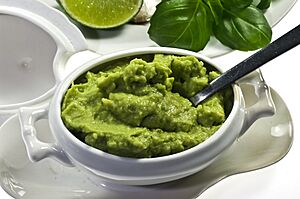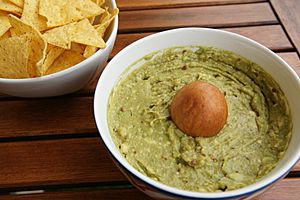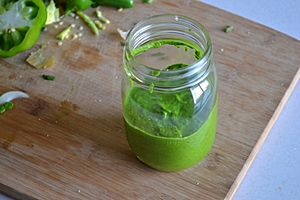Guacamole facts for kids

Guacamole
|
|
| Alternative names | Guac |
|---|---|
| Type | Dip |
| Place of origin | Mexico |
| Main ingredients | Avocados, salt, lime juice, onion, cilantro, tomato |
| Variations | Sour cream, basil |
| Similar dishes | Avocado sauce Mantequilla de pobre Venezuelan guasacaca |
Guacamole is a yummy dip, spread, or salad made mostly from avocados. It first came from Mexico. People often call it "guac" for short, especially in the United States. Today, guacamole is popular all over the world, not just in Mexican cooking. You can enjoy it as a dip, a topping, or even in salads!
Contents
What's in a Name? Guacamole's Origin
The word "guacamole" comes from an old language called Classical Nahuatl, which was spoken by the Aztec people in Mexico. It combines two words: āhuacatl (meaning 'avocado') and mōlli (meaning 'sauce'). So, "guacamole" literally means 'avocado sauce'!
The Story of Guacamole
Avocado seeds were first found in the Tehuacan Valley of Mexico a very long time ago, about 9,000 to 10,000 years ago. People in Central America started growing avocados by 5000 BCE. For a while in the early 1900s, avocados were sometimes called "alligator pears" because of their bumpy skin!
The first known description of a guacamole-like recipe was written in 1697. An English explorer named William Dampier visited Central America. He wrote about a local dish made by mashing avocados with sugar and lime juice.
Guacamole has become super popular in the U.S. It's especially a hit during big events like Super Bowl Sunday and Cinco de Mayo. This popularity grew after the U.S. government allowed avocados to be imported from Mexico in the 1990s.
What's in Guacamole?
Traditional guacamole is made by mashing ripe avocados with salt. This is often done using a special tool called a molcajete y tejolote, which is like a mortar and pestle.
Many recipes also add lime juice, fresh cilantro, onions, and spicy jalapeños. Some people like to add other ingredients like sour cream, tomatoes, basil, or even peas.
You might notice that guacamole can turn brown if left out. This happens because of something called polyphenol oxidase in avocados. When it touches air, it causes a natural color change. To keep guacamole green, you can store it in an airtight container. This stops the air from reaching it.
Guacamole's Goodness
Since guacamole is mostly raw avocado, it's packed with good stuff! Avocados have lots of fiber, which is good for your digestion. They also contain several B vitamins, vitamin K, vitamin E, and potassium.
Avocados are a source of healthy fats, like monounsaturated fat. They also have special plant compounds called phytosterols. Plus, they contain carotenoids like beta-carotene, zeaxanthin, and lutein, which are good for your body.
Dishes Like Guacamole
Guacamole has some relatives in the world of dips and sauces!
Mantequilla de pobre
Mantequilla de pobre means "poor-man's butter" in Spanish. It's a mix of avocado, tomato, oil, and citrus juice. Even though it's called "butter," it was made long before cows were brought to the Americas. So, it wasn't originally a butter substitute.
Guasacaca
Guasacaca is a sauce from Venezuelan cuisine. It's also made with avocado, but it's often thinner and more tangy than guacamole. It's usually made with vinegar and served with grilled foods, arepas, and empanadas. Sometimes, people add a little hot sauce instead of jalapeño.
Guacamole in Stores
You can buy ready-made guacamole in stores. It's often found in the refrigerated section. Some store-bought guacamoles use special packaging that helps them stay fresh longer. This process keeps the guacamole good even if it's not made fresh at home.
Guacamole Day!
Did you know there's a National Guacamole Day? It's celebrated on September 16th. This is the same day as Mexican Independence Day!
See also
 In Spanish: Guacamole para niños
In Spanish: Guacamole para niños



